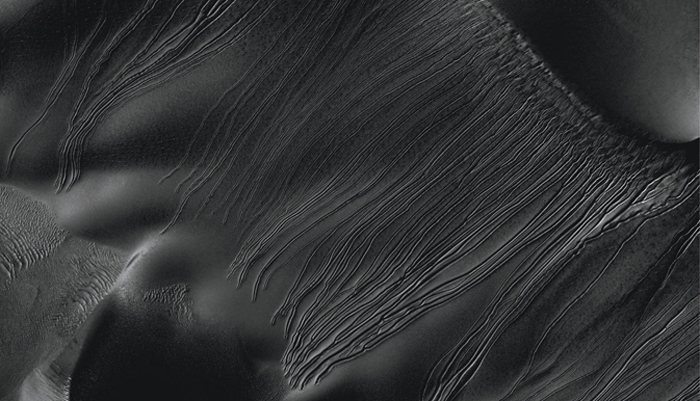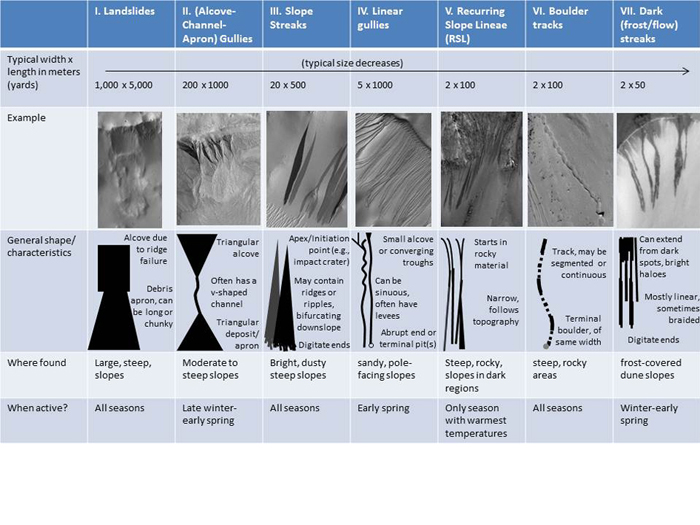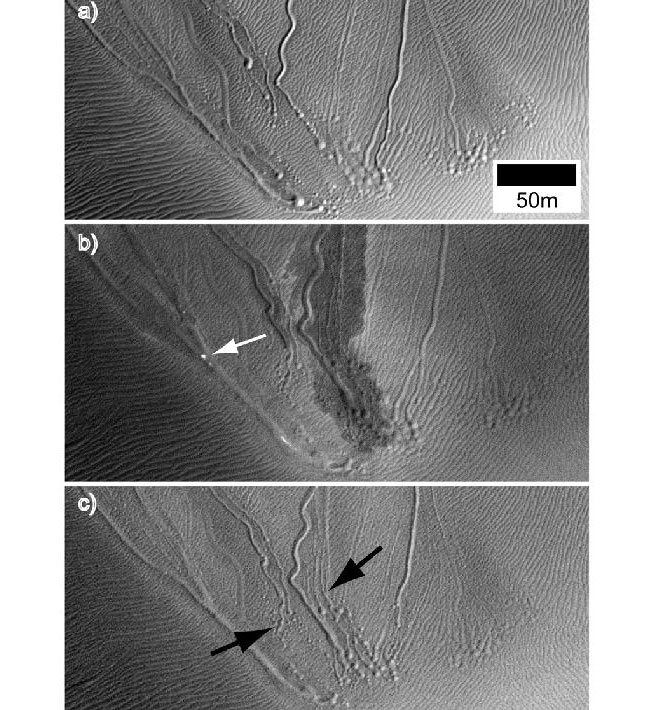.

Several types of downhill flow features have been observed on Mars. This image from the High Resolution Imaging Science Experiment (HiRISE) camera on NASA's Mars Reconnaissance Orbiter is an example of a type called "linear gullies." Image credit: NASA/JPL-Caltech/Univ. of Arizona ›
.
PASADENA, Calif. -- NASA research indicates hunks of frozen carbon dioxide -- dry ice -- may glide down some Martian sand dunes on cushions of gas similar to miniature hovercraft, plowing furrows as they go.
Researchers deduced this process could explain one enigmatic class of gullies seen on Martian sand dunes by examining images from NASA's Mars Reconnaissance Orbiter (MRO) and performing experiments on sand dunes in Utah and California.
"I have always dreamed of going to Mars," said Serina Diniega, a planetary scientist at NASA's Jet Propulsion Laboratory in Pasadena, Calif., and lead author of a report published online by the journal Icarus. "Now I dream of snowboarding down a Martian sand dune on a block of dry ice."
The hillside grooves on Mars, called linear gullies, show relatively constant width -- up to a few yards, or meters, across -- with raised banks or levees along the sides. Unlike gullies caused by water flows on Earth and possibly on Mars, they do not have aprons of debris at the downhill end of the gully. Instead, many have pits at the downhill end.
"In debris flows, you have water carrying sediment downhill, and the material eroded from the top is carried to the bottom and deposited as a fan-shaped apron," said Diniega. "In the linear gullies, you're not transporting material. You're carving out a groove, pushing material to the sides."
Images from MRO's High Resolution Imaging Science Experiment (HiRISE) camera show sand dunes with linear gullies covered by carbon-dioxide frost during the Martian winter. The location of the linear gullies is on dunes that spend the Martian winter covered by carbon-dioxide frost. By comparing before-and-after images from different seasons, researchers determined that the grooves are formed during early spring. Some images have even caught bright objects in the gullies.
Scientists theorize the bright objects are pieces of dry ice that have broken away from points higher on the slope. According to the new hypothesis, the pits could result from the blocks of dry ice completely sublimating away into carbon-dioxide gas after they have stopped traveling.
"Linear gullies don't look like gullies on Earth or other gullies on Mars, and this process wouldn't happen on Earth," said Diniega. "You don't get blocks of dry ice on Earth unless you go buy them."
That is exactly what report co-author Candice Hansen, of the Planetary Science Institute in Tucson, Ariz., did. Hansen has studied other effects of seasonal carbon-dioxide ice on Mars, such as spider-shaped features that result from explosive release of carbon-dioxide gas trapped beneath a sheet of dry ice as the underside of the sheet thaws in spring. She suspected a role for dry ice in forming linear gullies, so she bought some slabs of dry ice at a supermarket and slid them down sand dunes.
That day and in several later experiments, gaseous carbon dioxide from the thawing ice maintained a lubricating layer under the slab and also pushed sand aside into small levees as the slabs glided down even low-angle slopes.
The outdoor tests did not simulate Martian temperature and pressure, but calculations indicate the dry ice would act similarly in early Martian spring where the linear gullies form. Although water ice, too, can sublimate directly to gas under some Martian conditions, it would stay frozen at the temperatures at which these gullies form, the researchers calculate.
"MRO is showing that Mars is a very active planet," Hansen said. "Some of the processes we see on Mars are like processes on Earth, but this one is in the category of uniquely Martian."
Hansen also noted the process could be unique to the linear gullies described on Martian sand dunes.
"There are a variety of different types of features on Mars that sometimes get lumped together as 'gullies,' but they are formed by different processes," she said. "Just because this dry-ice hypothesis looks like a good explanation for one type doesn't mean it applies to others."
The University of Arizona Lunar and Planetary Laboratory operates the HiRISE camera, which was built by Ball Aerospace & Technologies Corp. of Boulder, Colo. JPL, a division of the California Institute of Technology in Pasadena, manages MRO for NASA's Science Mission Directorate in Washington. Lockheed Martin Space Systems, Denver, built the orbiter.
.

Martian Features Formed When Material Moves Downslope
As on the Earth, many processes can move material down a Martian slope. This graphic compares seven different types of features observed on Mars that appear to result from material flowing or sliding or rolling down slopes.
Processes that explain one type of downslope feature may be irrelevant to another type. Some processes depend on the presence of a fluid, some are driven by seasonal changes in the environment, and others occur randomly when gravity is able to pull down unstable slope material.
These different processes can generate a wide range of feature shapes, though sometimes different processes can yield similar-looking results. Thus, to figure out how a feature may have formed, more must be considered than its shape. For example, researchers examining images from Mars orbiters have found differences in
1. the season when the features are formed or are active (e.g., the features called "recurring slope lineae" or RSLs appear during late spring and summer, but linear gullies are active only during early spring);
2. the features' sizes (e.g., slope streaks can extend for miles or kilometers, but dark frost streaks on dunes extend only up to 100 yards, or meters); and
3. the types of terrain on which a feature is found (e.g., gullies with an alcove-channel-apron shape are found both on rocky slopes and on sandy slopes, but linear gullies are only found on sandy slopes; dark frost streaks are formed on frozen dune slopes, but RSLs are formed on dark, warm slopes).
Scientists consider all of these factors -- and more -- when trying to form a complete picture about a feature's formation history and in figuring out what the presence of that feature means about the environment.
The seven images of different types of downslope features come from three different NASA Mars orbiters. The image of a landslide comes from the Thermal Emission Imaging System (THEMIS) on NASA's Mars Odyssey. The images of alcove-channel-apron gullies and of slope streaks come from the Mars Orbiter Camera (MOC) in NASA's Mars Global Surveyor. The other images come from the High Resolution Imaging Science Experiment (HiRISE) on NASA's Mars Reconnaissance Orbiter.
The University of Arizona, Tucson, operates THEMIS. Malin Space Science Systems, San Diego, operated MOC. The University of Arizona, Tucson, operates HiRISE. NASA's Jet Propulsion Laboratory, a division of the California Institute of Technology in Pasadena, has managed the Mars orbiter projects for NASA's Science Mission Directorate, Washington.
.

Some Gullies on Mars Could Be Tracks of Sliding Dry Ice
These examples of one distinctive type of Martian gullies, called "linear gullies," are on a dune in Matara Crater, seen at different times of year to observe changes. The observations support a new hypothesis that chunks of frozen carbon dioxide, also known as "dry ice," may create linear gullies. In early Martian spring at some latitudes, dry-ice blocks may glide down sandy slopes on self-generated cushions of sublimating carbon-dioxide gas, plowing the grooves as they go and sometimes leaving pits where they stop sliding and sublimate away.
The three images were taken by the High Resolution Imaging Science Experiment (HiRISE) camera on NASA's Mars Reconnaissance Orbiter, of a site at 49.4 degrees south latitude, 34.7 degrees east longitude. The top image is from Mars southern-hemisphere early summer. The middle image is from the start of spring not quite two Martian years later. The white arrow points out a frost block, which appears very bright against the defrosting dune surface. The bottom image is from later the same spring. Black arrows indicate regions where new channels and pits appeared during the intervening seasons since the top image was taken. The scale bar is 50 meters (55 yards).
The three images are excerpts from HiRISE observations catalogued as ESP_013834_1300 (taken July 9, 2009); ESP_029038_1305 (taken Oct. 6, 2012) and ESP_029961_1305 (taken Dec. 17, 2012).
The University of Arizona Lunar and Planetary Laboratory operates HiRISE, which was built by Ball Aerospace & Technologies Corp., Boulder, Colo. NASA's Jet Propulsion Laboratory, a division of the California Institute of Technology in Pasadena, manages the Mars Reconnaissance Orbiter for NASA's Science Mission Directorate in Washington. Lockheed Martin Space Systems, Denver, built the orbiter.
.
Quelle: NASA
5237 Views

